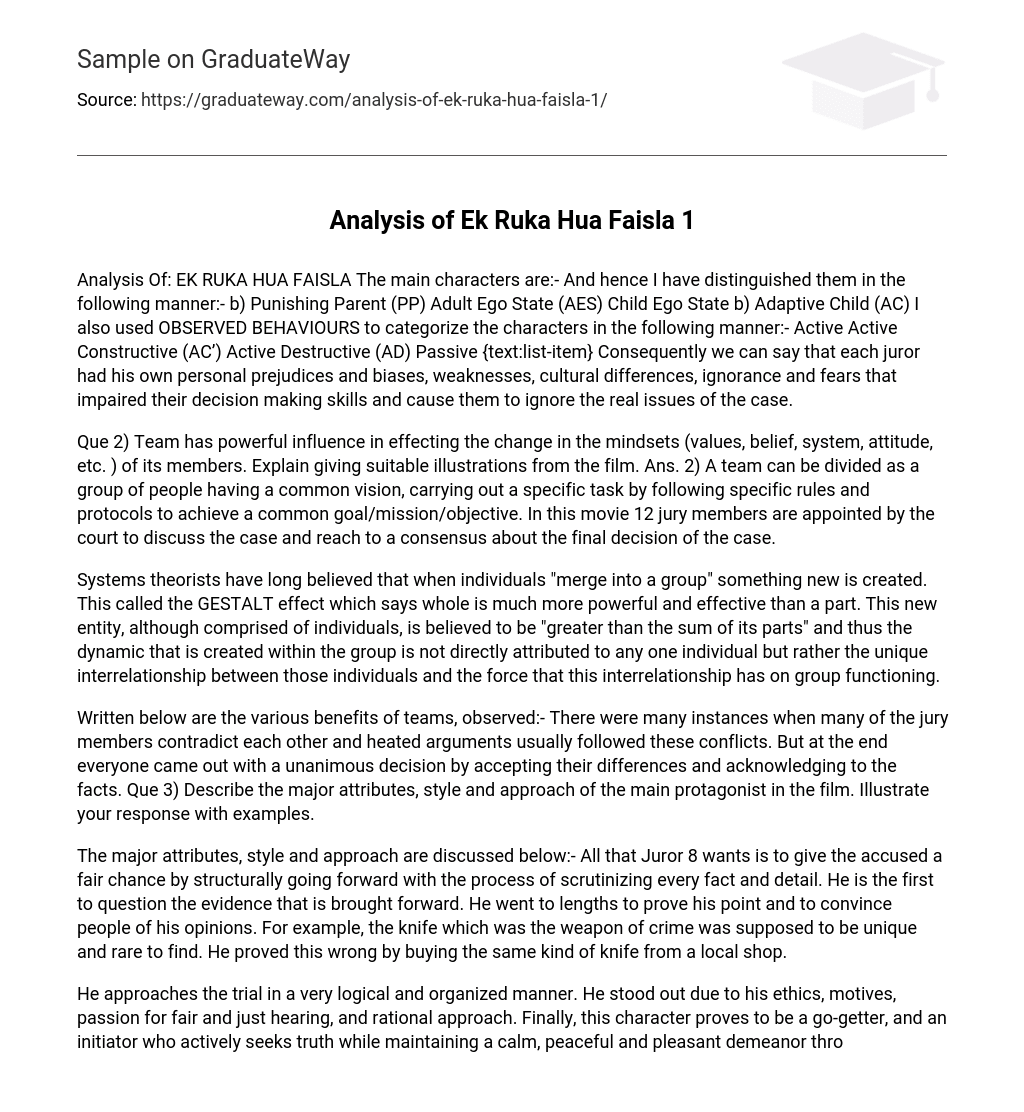Team has powerful influence in effecting the change in the mindsets (values, belief, system, attitude, etc. ) of its members. Explain giving suitable illustrations from the film.
A team can be divided as a group of people having a common vision, carrying out a specific task by following specific rules and protocols to achieve a common goal/mission/objective. In this movie 12 jury members are appointed by the court to discuss the case and reach to a consensus about the final decision of the case.
Systems theorists have long believed that when individuals “merge into a group” something new is created. This called the GESTALT effect which says whole is much more powerful and effective than a part. This new entity, although comprised of individuals, is believed to be “greater than the sum of its parts” and thus the dynamic that is created within the group is not directly attributed to any one individual but rather the unique interrelationship between those individuals and the force that this interrelationship has on group functioning.
Written below are the various benefits of teams, observed:- There were many instances when many of the jury members contradict each other and heated arguments usually followed these conflicts. But at the end everyone came out with a unanimous decision by accepting their differences and acknowledging to the facts.
Describe the major attributes, style and approach of the main protagonist in the film. Illustrate your response with examples.
The major attributes, style and approach are discussed below: All that Juror 8 wants is to give the accused a fair chance by structurally going forward with the process of scrutinizing every fact and detail. He is the first to question the evidence that is brought forward. He went to lengths to prove his point and to convince people of his opinions. For example, the knife which was the weapon of crime was supposed to be unique and rare to find. He proved this wrong by buying the same kind of knife from a local shop.
He approaches the trial in a very logical and organized manner. He stood out due to his ethics, motives, passion for fair and just hearing, and rational approach. Finally, this character proves to be a go-getter, and an initiator who actively seeks truth while maintaining a calm, peaceful and pleasant demeanor throughout the procedure despite of being provoked a number of times. Being an achiever and a confident man he actively listens to his fellow jurors’ opinions and point of views, and encourages them to think and rationalize.
Outline the lessons learnt from the movie particularly with reference to the role of group processes and process facilitation in making team an effective medium of change.
The central route is the process by which a person carefully ponders upon a communication and is eventually influenced by the power of argument. Juror #8 and Juror #4, both follow this approach towards attitudinal change. Juror #8 appeals for the accused’s innocence in a well-thought, organized and elucidated manner.
He stipulates his points through empirical evidence and eventually sways the other jurors. The central route to persuasion characterized Fonda’s approach. Likewise, the businessman uses his curt, stoic and inductive nature to create a strong, convincing argument based on facts. Lastly, Juror #11 applies the central route to persuasion when he advocates, “going deeper,” in reference to an examination of the facts. The peripheral route of persuasion is characterized by superficial cues surrounding the argument rather than validity of the facts presented in the argument.
Juror #10 and 7 display this kind of an approach. Where on one hand Juror #10 very inappropriately urges other jurors to construe an attitude based on peripheral ethnic and racial cues, Juror #7 asks them to get away with the decision as soon as possible since there is no use in discussing the facts as maximum number of them were convinced the boy was guilty. Through the use of non-factual, environmental cues, the sick gentlemen utilizes the peripheral route to persuasion. Route selection is another component of relevance in the movie.
The jurors who care deeply about the fate of the accused boy, are concerned with justice, take pride in their intellect regardless of social status, and are involved in discussion susceptible to the central route. Those who are not able to understand the complexity of the trial, are distracted and pressed for time tend to take the peripheral route. This phenomenon is exemplified by the Juror #10 who complains about his business being interrupted and speaks English poorly, Juror #7 who urgently wants to make it to the movie theatre and finally by Juror #3 who is distracted by his own personal rage, brought forth by the young accused boy.
So it can be seen that the way a group works can highly influence the working capacity and the effectiveness of the decisions made by them. Juror #8’s adherence and conviction to evaluating the case is an example of social compensation. This character believes in the justice and morality implied within the constitutional guarantee afforded by the jury process.
Hence it becomes emperative for any team to give there team members the following: Equal and fair chance to voice their opinions good space for Self-Observation. A welcoming and supporting environment i. e. a condusive environment for Self-Disclosure. Experience trust, acceptance and understanding within the team. Vicarious learning i. e. a chance to pick up skills and attitudes from others. Good insight to expand self-knowledge. Share other people’s experiences- concerns, difficulties and hopes. This will indeed make the team an effective medium of change.





